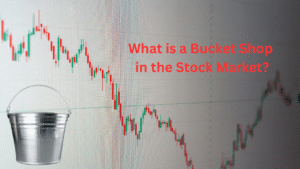 What is a Bucket Shop in the Stock Market? A Complete Guide to This Risky Practice
What is a Bucket Shop in the Stock Market? A Complete Guide to This Risky Practice
Learn what a bucket shop is in the stock market, how it operates, its history, legal issues, and how to spot and avoid modern-day bucket shop scams.
Understanding the Bucket Shop Phenomenon
If you’re diving into the world of investing and trading, you may have come across the term “bucket shop.” While it might sound harmless or even quaint, it is anything but. These shady brokerage firms have a notorious history of scamming traders, and even today, bucket shop tactics can be found in the shadows of financial markets.
In this article, we’ll explore what a bucket shop is, how it operates, its history, and most importantly, how to protect yourself from modern-day equivalents. Whether you’re a beginner or a seasoned trader, knowing how bucket shops work can help you make safer investment decisions.
What is a Bucket Shop in the Stock Market?
A bucket shop is a fraudulent or unlicensed brokerage that takes trades from customers but never actually executes them on a legitimate exchange. Instead, the firm records the trade internally and essentially bets against the customer.
When you “buy” or “sell” through a bucket shop, you’re not actually entering the market. Instead, the bucket shop keeps your order in a metaphorical “bucket,” hoping you lose so they can pocket your money.
This practice is inherently deceptive and creates a conflict of interest: the more you lose, the more the bucket shop earns.
How Bucket Shops Work
Here’s a simplified step-by-step breakdown of how a bucket shop operates:
- You place a trade – For example, you buy 100 shares of a stock at $50.
- The shop doesn’t place the trade on a real exchange. They merely log it in their own books.
- The firm “bets” against you – They want the stock to go down, so they keep the $5,000 you paid if it does.
- If the stock goes up, they may try to avoid paying you by making up excuses, delaying withdrawals, or shutting down operations entirely.
Bucket shops may even manipulate fake price data to make it seem like you lost the trade, even if the real market moved in your favor.
A Brief History of Bucket Shops
Bucket shops were rampant in the late 19th and early 20th centuries, especially in the United States. These establishments catered to small-time speculators who wanted to bet on stock prices without actually buying or selling shares.
The famous American author and trader Jesse Livermore got his start in bucket shops, using price patterns to beat them at their own game. Eventually, bucket shops were recognized as fraudulent and outlawed.
The Bucket Shop Act of 1909 and later regulatory efforts helped shut many of them down. However, the spirit of the bucket shop lives on in unregulated forex platforms, binary options scams, and some crypto exchanges operating today.
Key Characteristics
To help you spot a bucket shop, here are some common traits:
- Lack of proper licensing or regulation
- No proof that trades are routed to real markets
- High-pressure sales tactics
- Guaranteed profits or suspiciously high leverage
- Manipulated prices or data feeds
- Difficult withdrawal processes or disappearing funds
- Conflicts of interest (they profit when you lose)
Modern-Day Bucket Shops: They Still Exist
Although traditional bucket shops have mostly disappeared, modern-day scams have taken their place, often in the form of:
- Unregulated Forex brokers offering high leverage and no transparency
- Binary options websites promising huge returns
- Shady crypto exchanges with unclear trading mechanics
- CFD brokers operating without oversight
These platforms may advertise on social media or target beginners with no trading experience. If you see unrealistic promises like “Double your money in 24 hours”, it’s a major red flag.
Is Running a Bucket Shop Illegal?
Yes, it is illegal in most countries, including the United States. Financial authorities like the U.S. Securities and Exchange Commission (SEC) and Commodity Futures Trading Commission (CFTC) actively investigate and shut down these operations.
Under laws like the Dodd-Frank Act and the Securities Exchange Act of 1934, firms must be registered and meet strict operational standards to serve customers.
If a broker is not regulated by agencies like the SEC, FINRA, FCA (UK), or ASIC (Australia), you should be extremely cautious.
How to Protect Yourself from Bucket Shops
Here are several tips to keep yourself safe:
1. Verify Broker Licensing
Before opening an account, check if the broker is registered with a reputable regulator.
2. Avoid “Too Good to Be True” Offers
If someone guarantees quick profits or unusually high returns, it’s likely a scam.
3. Look for Transparency
Legit brokers disclose how trades are executed and where your money is held.
4. Test Withdrawals
Make a small deposit and request a withdrawal early. If there are delays or excuses, walk away.
5. Read Reviews and Forums
Research what others say about the platform. Frequent complaints about manipulation or lost funds are warning signs.
Real-Life Examples of Bucket Shop Practices
- A user deposits $1,000 into a forex trading platform that promises 300% returns.
- After a few “trades,” their balance drops to zero due to fake price movements.
- The platform either disappears or blames “market volatility.”
- There’s no recourse because the firm is located in a non-regulated offshore zone.
This kind of behavior is classic bucket shop fraud.
Conclusion: Stay Informed, Stay Safe
While the term “bucket shop” may sound outdated, the tactics used by these fraudulent operations are still alive in the digital age. Whether you’re trading stocks, forex, or crypto, it’s crucial to deal with reputable, regulated brokers and remain skeptical of any platform that seems too good to be true.
Bucket shops thrive on ignorance and greed—two things you can avoid with proper education and research. By understanding what a bucket shop is and how it operates, you protect yourself and your investments from unnecessary risk.
